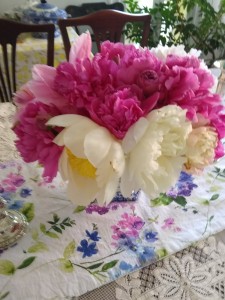 Only eight short weeks ago, gardeners in my part of the world were rhapsodizing over the diminutive glories of snowdrops and crocuses. Now, even the foliage is gone with the wind, and the memory of their charms has been washed away in the high tide of one of the greatest floral show horses of all—the peony.
Only eight short weeks ago, gardeners in my part of the world were rhapsodizing over the diminutive glories of snowdrops and crocuses. Now, even the foliage is gone with the wind, and the memory of their charms has been washed away in the high tide of one of the greatest floral show horses of all—the peony.
The peonies are blooming. In my garden this over-the-top show begins with a red-flowered Chinese tree peony or Paeonia suffruticosa that I bought years ago. It was supposed to have been a yellow-flowered shrub, but it didn’t even pop a blossom until two years after it arrived. By that time a refund was out of the question. Since the color was lovely on its own, I reconciled myself to waiting a little longer for a yellow one.
I also grow a lovely, pink-flowered tree peony that was given to me a decade ago by a friend who was moving. It is not as big and bold as the not-yellow tree peony, but bears gorgeous shell-pink double blooms that burst out ahead of the other peonies.
The tree peonies have shed their petals already, but they were only the opening act. Now the herbaceous or garden peonies, otherwise known as Paeonia lactiflora, are in their element. One of my favorites, ‘Festiva Maxima’, bears enormous pouffy white flowers that conceal small streaks of red within their multitudes of petals. ‘Festiva’ is an old variety, dating back to 1851 and a French breeder named Auguste Joseph Meillez. The plants can grow as tall as four feet, with the deeply dissected foliage characteristic of garden peonies. At eight inches or more in diameter, it only takes a few ‘Festiva’ flowers to fill a bowl.
Good plant breeders generally beget, or at least influence other plant breeders. That may have been the case with Meillez, who supposedly influenced Victor Lemoine, fabled breeder of gorgeous and romantic peonies, lilacs, fuchsias, begonias, and mock oranges, to name a few. One of Lemoine’s finest, which is still in commerce today, is ‘Sarah Bernhardt’, named for the great French tragedienne and introduced in 1906. To quote a catalog, ‘Sarah’ is “large, double, dark rose pink” and strongly fragrant. Unlike the actress, who took her final bows over a century ago, ‘Sarah Bernhardt’ is still going strong.
For a long time I thought that I had ‘Sarah’ in the garden. When I moved into my house, I found a single peony stem sprouting bravely under a large holly tree. I expect it was planted when the holly was young and forgotten as it grew to immense size. I dug the peony out carefully, only to have the root break apart in my hands at the end of the process. I planted both halves in a sunny spot. The halves have prospered, and my back garden is now home to two large clumps of dark pink peonies that smell divinely of roses.
I assumed that my mystery plant was ‘Sarah’ because it bore the characteristic rose fragrance. More recently though, I have decided that the flowers on my burgeoning clumps look more like those of ‘Edulis Superba’, which is even older than ‘Festiva Maxima’ or ‘Sarah Bernhardt’, having been introduced by the French breeder Nicholas Lemon in 1824.
Whatever the name of my rose-scented beauty, it has been joined over the years by other peonies, including the huge ‘Crinkled White’, which looks a bit like a giant poppy, with crepe paper-like single petals around a giant cluster of golden stamens. ‘Raspberry Sundae’ is as American as its name suggests, bred by the wonderful Carl Klehm before 1951. I still lament the fact that the fabulous Song Sparrow Nursery, home to the Klehm family, is no more. Their array of beautiful peonies—some bred by the Klehms and some from other breeders—was superb.
At least I have several Klehm peonies, including ‘Raspberry Sundae’, to remember them by. The flowers are big and double, combining pink, white and pale yellow in each bloom.
And finally, years after the not-yellow peony arrived, I acquired two yellow-flowered peonies. They are not garden peonies or tree peonies, but a hybrid of the two species. In the nursery trade this type of plant is known as an “intersectional” peony. My two are ‘Bartzella’, with large, double yellow blooms, accented sometimes by a few red flares on the petals’ outsides, and clusters of yellow stamens. The ‘Bartzella’ in my front strip, holding forth under the Carolina silverbell tree, always provokes admiring comment, with its big, upturned blooms. Its sibling, in my lower back garden, bears the same blooms, but the stems are always too weak to support the big flowerheads, so they droop. I have tried to remedy the situation by tying them up and propping them up. Next year I will get proper peony supports for my back garden ‘Bartzella’, so the plant can be as showy as its front garden counterpart.
Last night I dreamed about peonies, so this morning I went out and clipped enough flowers and buds to fill a big pitcher. As May winds down, this all-peony arrangement is the ultimate luxury.
